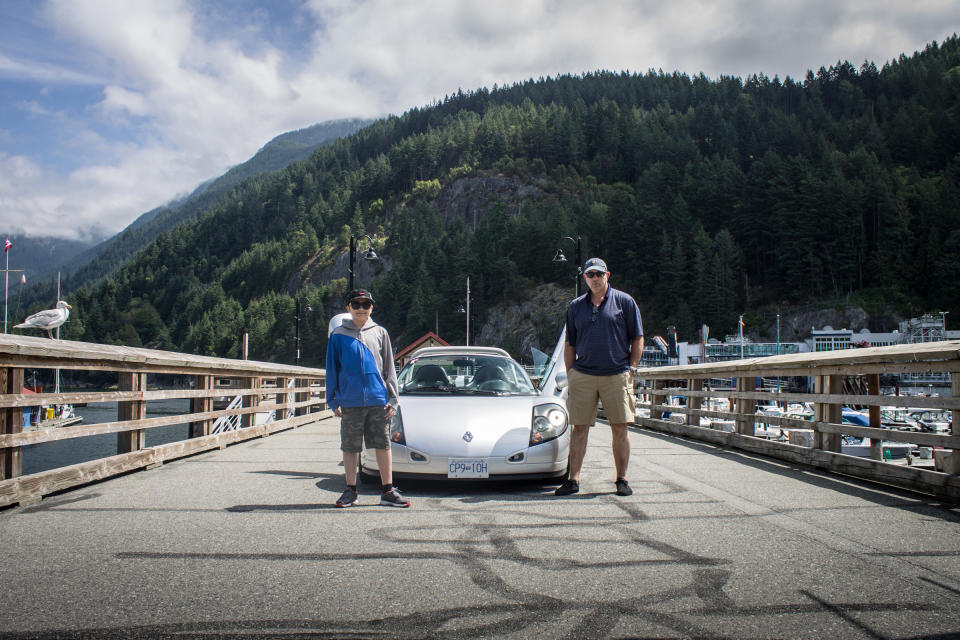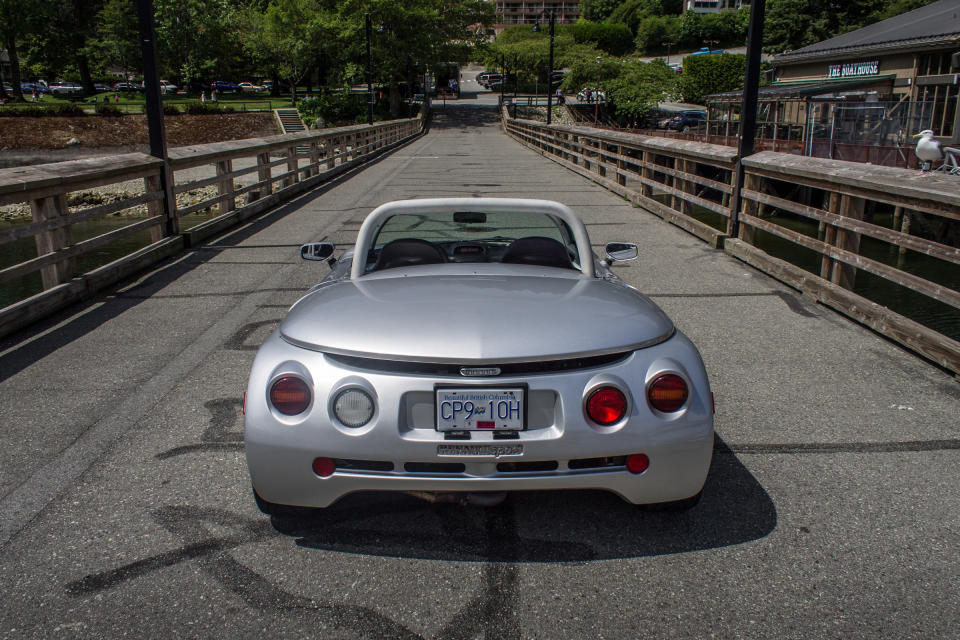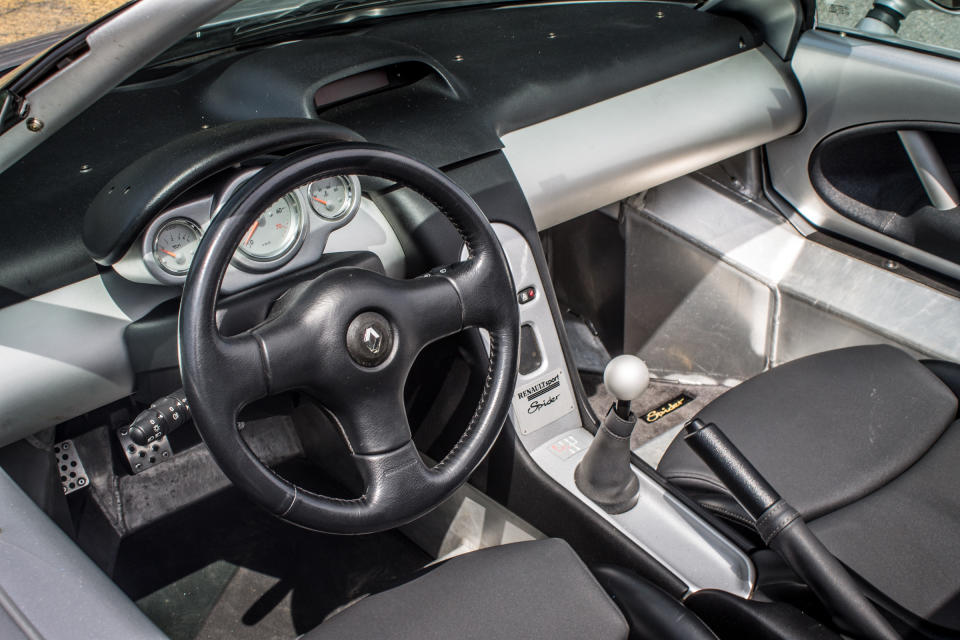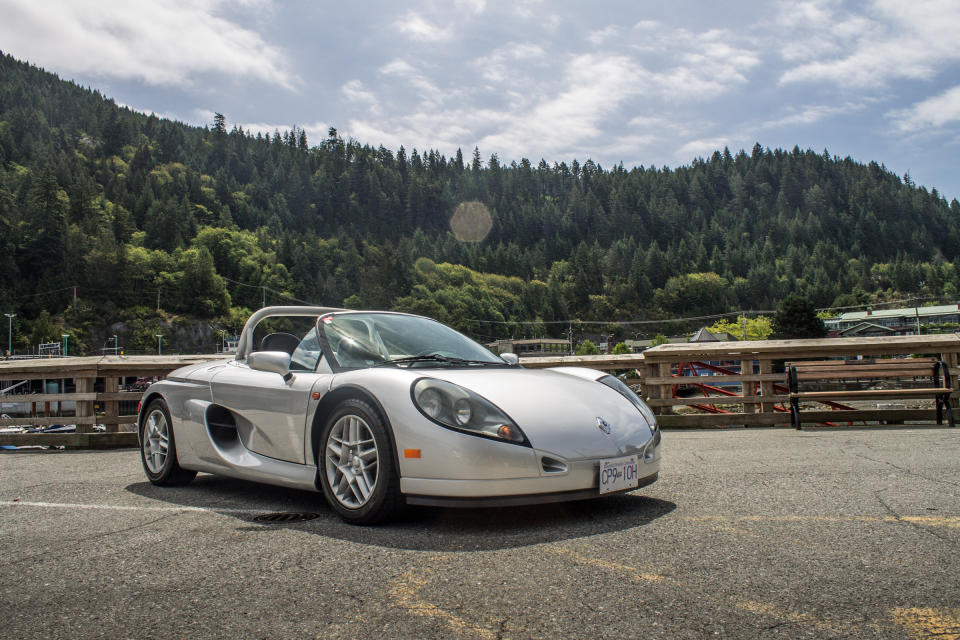The Renault Sport Spider Was a Wonderful French Twist on a Lotus Elise

What we have here is effectively a croissant designed for hand-to-hand combat. It is small, lithe, airy, unexpected. It is French, weird, low, agile. It is a car that comes to you from the high-water mark of Renault's Formula 1 years, an aluminum and fiberglass confection of speed.
Ça vous dit? Allons-y!
This is a Renault Sport Spider, and it's completely crazy. If you set one bookend at the Citroën DS and its incredible floating oleo pneumatic suspension, then this sits at the other end of the shelf. It's like a French twist on the Lotus Elise. With roughly 1600 examples made between 1996 to 1999, it is only slightly less rare than a Ferrari F40. Its high-mount roll-bar sticks up over driver and passenger, looking like a roller-coaster car that's just escaped from Euro Disneyworld.
"It's the closest thing I've driven to my old Formula Ford," says owner John Alevras, shouting to be heard over the revvy little 2.0-liter located amidships. I spotted the car on the lawn at a local annual gathering of French and Italian automobiles in my hometown of North Vancouver, Canada, and arranged a ride-and-drive-something John was only too happy to provide. He bought the car in May, importing it from Japan under Canada's relatively lax 15 year gray market rules. It's a 1998, but it has just 16,000 kms (10,000 miles) on the odometer.

Such low mileage is understandable, because the Sport Spider is about as practical for everyday use as a hat made out of a chocolate soufflé. There are zero concessions to comfort, storage is tight, the interior is essentially just exposed bits of the welded aluminum chassis, and the tonneau roof is completely ineffective. Also, only Goscinny and Uderzo's diminutive hero Astérix could sit in the driver's seat without his head poking up over the windshield.
The Sport Spider is about as practical for everyday use as a hat made out of a chocolate soufflé.
A windshield, incidentally, that's an optional extra. The Spider was also sold with a tiny wind deflector, the idea being that you'd drive around in a motorcycle helmet or risk having the skin peeled off your head like the rind of a Mediterranean orange. Such French silliness seems absurd until you remember that Renault also thought it would be fun to stuff an F1 V12 with exposed intake trumpets into a minivan.
In the 1990s, Renault was entering boom times. Cars like the Mégane were selling well, and the company's F1 efforts were meeting with success. In 1993, the highly advanced Renault-Williams FW15 helped Alain Prost drive to his fourth and final world championship-a Frenchman in a French car at the pinnacle of motorsport. Renault-Williams would claim the Constructor's Championship as well that year.

Spirits were high, and Renault saw the opportunity to leverage its successes for further profit. The waters had already been tested with a concept car, the ultra-wacky Laguna Roadster. Shown in Paris in 1990, the Laguna looked a bit like an open-topped Power Wheels version of an Alpine A110. It came with a set of Robocop-style goggles for both driver and passenger and had seats patterned like those on an airport shuttle bus. The crowds loved it.
Work on a production Spider began in September of 1993. A running prototype built around a 2.0-liter four-cylinder sourced from the Megan coupe began testing on the road the following year. Claude Fior, the designer, was given almost total cart blanche apart from the engine requirement. An experienced racing motorcycle builder, he created essentially a scaled-down race car with an aluminum spaceframe clothed in fiberglass.
Weight was 2050 lbs. The Megane 2.0-liter made 148 hp in road-going trim and 180 hp in the racing version. Suspension was double-wishbone, with the dampers located inboard to keep the car extra low. The brakes were sourced from the much larger and heavier Alpine 610.
Each car was hand-built in the Alpine's Dieppe factory and available with very few options. ABS wasn't on the list. Neither was a heater. You could get a radio if you really wanted.

Eighty track-only Trophy models were also built, each one getting the horsepower bump and a 6-speed transmission (the road-going car makes do with five). A single-make series called the Spider Trophy launched the racing careers of several well-known drivers, including British Touring Car Champion and sometime television star Jason Plato.
Alevras had his own racing career, starting out in karts at Westwood in his early twenties, and eventually moving up to Formula Ford open-wheelers. The pressures of raising two boys and running a business forced him off the circuit, but as his sons grew, he found himself looking for a sports car again. He came across the Spider on a Japanese auction site, and recognized it immediately.

"I remembered [Renault] bringing one to the Vancouver Molson Indy circuit years ago," he says. "It just clicked."
Alveras pulls the removable cushions out of his Renault whenever he takes it for a drive. At 240 lbs, he says he's too big to fit easily into an Elise. The Spider, weirdly, is actually quite roomy despite the low height of the windshield. I swap into the driver's seat: Getting in and out requires a bit of contortion, but once settled in, it's nearly comfortable.
The car corners completely flat, suctioned to the tarmac with huge mechanical grip. The steering is totally unassisted and hugely heavy, minor inputs equaling an immediate response from the chassis. The brakes require a firm foot on the pedal, and the 2.0-liter zings up in the revs with light throttle pressure.

Scampering along an old piece of the Sea-to-Sky highway, the car feels deft and eager and raw and vibrant. The whole road to the resort town of Whistler used to be like this, a narrow thread between rocky cliffs and the choppy waters of the sound. It's a little secret nook, rising up from the water to join the main freeway; below us, holiday-makers are lining up in Horseshoe Bay to take the ferry across to Vancouver Island.
In the Spider, you experience everything in its immediacy, speed and sound and smell from the outdoors.
It's a perfect day, bright and sunny, with a whiff of pine coming off the trees crowding close to the road. In the Spider, you experience everything in its immediacy, speed and sound and smell from the outdoors. The little Renault is something very special indeed, and despite its odd and foreign origins, there's a familiar story here, too.
John's son David is waiting to welcome us back from the drive. When I first met the pair at the car show, the 13-year-old was fielding questions from onlookers about his father's car. He rattled off specs, production run, and provenance like the car was his.

The pair have begun working together on the Spider already, fitting a third brake light required by Canadian transport law. David wants to become an engineer, he's fascinated by the exposed mechanicals of the Spider. As it's such a simple car, working on it is relatively easy, and John has been able to find sources for most parts from fellow enthusiasts in the UK and France. Come winter, the plan is to get the Spider up on jackstands and begin going through it to address any minor deficiencies.
David fields a call from Mom-the family is headed out of town on a long holiday, and there's still packing to be done. John and I are talking about the local car shows, planning the next meet up. He mentions one out in a suburb South of the city that evening. David's ears perk up.
"Hey, can we go there tonight, Dad?"
John shakes his head, thinking of chores yet to do. Then he says, "Maybe."
The pair head out in their little French roadster, off to take the long route back home. It's an oddball of a car, and tiny. And yet, it's still big enough to carry all the things that really matter.

 Yahoo Autos
Yahoo Autos 